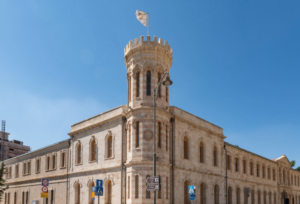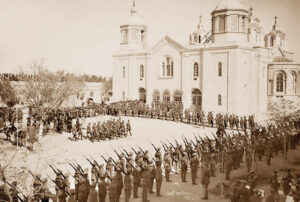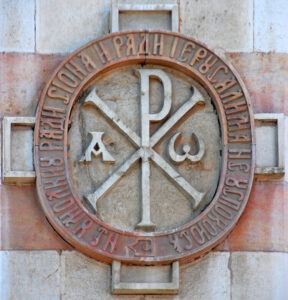The Russians in Jerusalem
Over 10,000 Russians went on pilgrimage to Jerusalem for Easter in 1911. Jerusalem only had 35,000 residents. The city’s population increased by a third for one week, and all for a scheme to maintain the authority of the Russian Monarchy- a monarchy that would fall six years later anyway. Most of those pilgrims were sincere in their ‘desire to fulfil the dream of praying at the Tomb of Jesus Christ’, to quote the handbook of the Imperial Orthodox Palestine Society. Many of them would walk all the way from their homes to Jerusalem. Nevertheless the royal family financed the hostels the pilgrims stayed in, the churches they worshipped in. These buildings were an attempt to build ‘Holy Russia’ in Jerusalem. They are still standing. The Holy Russian Empire that built them is not.
THE SERGEI GUESTHOUSE
The Russian Compound is a ten minutes walk from the Old City. The buildings in this once walled compound, display a rigid adherence to neo-classical principles. The clean, symmetrical buildings, all grand columns and simple features, convey a sense of order, even peace, away from the rest of the restless city. This impression of grandeur can only have been more manifest when the buildings were the only ones on this hill, above the Old City. Nearly all the compound was built between 1860 and 1890 and the purpose of the buildings was to be hostels for pilgrims. The only exceptions to the neoclassical style serve to enhance the dignity of the compound. A renaissance-style tower breaks the neoclassical order of the Sergei Guesthouse, built for aristocratic pilgrims in the 1880s. Nevertheless the luxury of the building reinforces the grandeur of the compound. The other exception is the Cathedral of the Holy Trinity, consecrated in 1872. Its baroque domes add some drama to the Compound without distracting from its order. The other two major Russian buildings in the city continue this theme of making a statement. The gold, onion-shaped domes of the Church of Mary Magdalene, consecrated in 1888 and built in a Muscovite style, are the most eye-catching feature of the Mount of Olives. Finally a baroque style gives a noticeable elegance to the Church of St Alexander Nevsky in the Old City. These Russian financed buildings are all about splendour on a grand scale.
THE CATHEDRAL OF THE HOLY TRINITY, 1917
The local Arabs swiftly coined the term ‘al-moscobiyyeh’ for the Russian Compound. Arabic already had an adjective for Russian. This focus on the city over nationality demonstrates a conception of the compound as a clearly separate entity with a single identity. Mass pilgrimage and the influence of the Russian royal family were the reasons for this consistency in architecture, and thus the impression of a Russian city transported to Jerusalem. Russian pilgrimage to Jerusalem was a regular feature of life in the city long before the European states began taking an interest. Edward Gibbon was on his normal form when describing the Festival of the Holy Fire: “This pious fraud, first devised in the ninth century, was devoutly cherished by the Latin crusaders, and is annually repeated by the clergy of the Greek, Armenian, and Coptic sects, who impose on the credulous spectators for their own benefit and that of their tyrants.” Nevertheless the annual festival on Holy Saturday drew pilgrims from across the Orthodox world, including the Russians that Gibbon neglected to mention, to witness the appearance of a flame in the Tomb of Jesus. These pilgrims needed somewhere to stay and in 1847 the Russian Ecclesiastical Mission was sent to Jerusalem to organise them. The REM, and other organisations controlled by the royal family, set about purchasing land and building hostels. These organisations were financed and controlled by the royal family and so they, usually the brother of the Tsar, directed the building operations. They also worked to encourage more pilgrims, establishing the Russian Steamship Company to ease the passage across the Black Sea. The strong identity of the Russian Compound was the result of this royal oversight, but the demand was created by the pilgrims.
The locals’ conception of the Russian compound as al-moscobiyyeh may also be a reflection of the other significant quality of Russian buildings in Jerusalem: how fast they appeared. When you walk around the compound, it feels as if all the buildings were built in the same year. The dates on the buildings blend into one. The first plots were purchased in 1858, most of the hostels were built by 1865, and the 17-acre compound was complete by the 1880s. The buildings do not appear to be hastily built but they were put up with remarkable speed. The official British presence had arrived in the city in 1838, the Prussians in 1842, the French in 1843. Even the Americans arrived in 1844 and they had no citizens in Jerusalem, nor interest in European politics. The Russian Ecclesiastical Mission was a strictly religious organisation and it suspended its activities in Jerusalem during the Crimean War of 1853 to 1856 anyway. It was 1858 before a Russian consulate appeared in Jerusalem. The other European powers had begun building, establishing their power in the city and they did not have the hassle of several thousands of their citizens arriving on pilgrimage every year. The Russians were late to the party in Jerusalem and so they set about establishing their presence systematically and at speed.
The Russian royal family were overcompensating. The Crimean War was a shock to a royal house and it could have been avoided if the Russians had got people on the ground to play the game of religious politics in Jerusalem. The trigger for the war had been the theft of a silver star from the Church of the Nativity in Bethlehem. The French demanded the right to replace the star, and to make changes to the Church of the Holy Sepulchre: all the normal stuff of religious politics in Jerusalem. Lacking an official presence on the ground, Tsar Nicholas escalated the conflict by threatening to invade Ottoman lands, if the Ottoman government granted the French demands. Before long, the three major European powers- Britain, France and Russia- were at war and Russia ended up humiliated. The loss of military prestige, and the loss of territory in the peace negotiations, broke Nicholas and he died shortly after. His successor, Alexander II, began the overcompensating, sending his brother on an official visit to Jerusalem. The brothers saw the opportunity to restore prestige to the monarchy by adding devotion of the tsar to the individual pilgrim’s devotion of Christ. They founded the Imperial Orthodox Palestine Society and its logo, nicely reminiscent of the Chi-Rho symbol for Christ, is clearly displayed on many of the Russian buildings. Alexander II’s successor, Alexander III, took it a stage further. The Russian monarchy was now the fulfilment of the Resurrection and some dodgy archaeology on Russian land in the Old City was meant to prove this narrative.
THE IMPERIAL ORTHODOX PALESTINE SOCIETY LOGO
By 1902, the Imperial Orthodox Palestine Society was holding over 30,000 meetings a year across Russia. These meetings informed pilgrims that Holy Russia was waiting for them in Jerusalem. It was their solemn duty to go to honour the Tsar and Christ. The coherence of Russian architecture, its grandeur, its scale stand in contrast to the individual and sporadic nature of British buildings in the city. The British were trying to convert locals though, not house 10,000 pilgrims. The Russian Compound shows what you can do in Jerusalem with some questionable archaeology, some impressive buildings, and the marriage of religion with a political myth.









